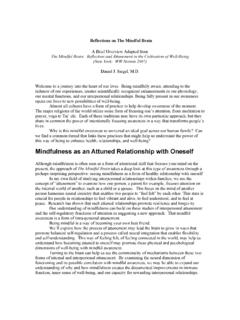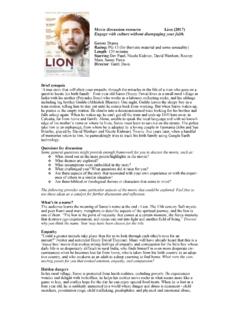Transcription of Ethical Decision Making and Behavior - SAGE Publications
1 7. Ethical Decision Making and Behavior As we practice resolving dilemmas we find ethics to be less a goal than a pathway, less a destination than a trip, less an inoculation than a process. Ethicist Rushworth Kidder WHAT'S AHEAD. This chapter surveys the components of Ethical Behavior moral sensitivity, moral judgment, moral motivation, and moral character and introduces systematic approaches to Ethical problem solving. We'll take a look at four Decision - Making formats: Kidder's Ethical checkpoints, the SAD formula, Nash's 12 questions, and the case study method. After presenting each approach, I'll discuss its relative advantages and disadvantages. U nderstanding how we make and follow through on Ethical decisions is the first step to Making better choices; taking a systematic approach is the second. We'll explore both of these steps in this chapter.
2 After examining the Ethical Decision - Making process, we'll see how guidelines or formats can guide our Ethical deliberations. 235. 236 PART III. Ethical Standards and Strategies Components of Moral Action There are a number of models of Ethical Decision Making and action. For example, business ethics educators Charles Powers and David Vogel identify six factors or elements that underlie moral reasoning and Behavior and that are particularly relevant in organizational The first is moral imagination, the recognition that even routine choices and relationships have an Ethical dimension. The second is moral identification and ordering, which, as the name suggests, refers to the ability to identify important issues, determine priorities, and sort out competing values. The third factor is moral evaluation, or using analytical skills to evaluate options.
3 The fourth element is tolerating moral disagreement and ambiguity, which arises when managers disagree about values and courses of action. The fifth is the ability to integrate managerial competence with moral competence. This integration involves anticipating possible Ethical dilemmas, leading others in Ethical Decision Making , and Making sure any Decision becomes part of an organization's systems and procedures. The sixth and final element is a sense of moral obligation, which serves as a motivating force to engage in moral judgment and to implement decisions. James Rest of the University of Minnesota developed what may be the most widely used model of moral Behavior . Rest built his four-component model by working backward. He started with the end product moral action and then determined the steps that produce such Behavior .
4 He con- cluded that Ethical action is the result of four psychological subprocesses: (1) moral sensitivity (recognition), (2) moral judgment, (3) moral focus (motivation), and (4) moral Component 1: Moral Sensitivity (Recognition). Moral sensitivity (recognizing the presence of an Ethical issue) is the first step in Ethical Decision Making because we can't solve a moral problem unless we first know that one exists. A great many moral failures stem from Ethical insensitivity. The safety committee at Ford Motor decided not to fix the defective gas tank on the Pinto automobile (see Chapter 2) because members saw no problem with saving money rather than human lives. Wal-Mart was slow to respond to concerns raised by employees, labor groups, environmen- talists, and others about wage violations, sexual discrimination, poor envi- ronmental practices, and other Many students, focused on finishing their degrees, see no problem with cheating.
5 (You can test your Ethical sen- sitivity by completing the Self-Assessment: Moral Sensitivity Scenarios. ). According to Rest, problem recognition requires that we consider how our Behavior affects others, identify possible courses of action, and determine the CHAPTER 7. Ethical Decision Making and Behavior 237. consequences of each potential strategy. empathy and perspective skills are essential to this component of moral action. If we understand how others might feel or react, we are more sensitive to potential negative effects of our choices and can better predict the likely outcomes of each option. A number of factors prevent us from recognizing Ethical issues. We may not factor Ethical considerations into our typical ways of thinking or mental We may be reluctant to use moral terminology (values, justice, right, wrong) to describe our decisions because we want to avoid contro- versy or believe that keeping silent will make us appear strong and We may even deceive ourselves into thinking that we are acting morally when we are clearly not, a process called Ethical fading.
6 The moral aspects of a Decision fade into the background if we use euphemisms to disguise unethical Behavior , numb our consciences through repeated misbehavior, blame others, and claim that only we know the truth. 6. Fortunately, we can take steps to enhance our Ethical sensitivity (and the sensitivity of our fellow leaders and followers) by doing the following: Active listening and role playing Imagining other perspectives Stepping back from a situation to determine whether it has moral implications Using moral terminology to discuss problems and issues Avoiding euphemisms Refusing to excuse misbehavior Accepting personal responsibility Practicing humility and openness to other points of view In addition to these steps, we can also increase Ethical sensitivity by Making an issue more salient. The greater the moral intensity of an issue, the more likely it is that Decision makers will take note of it and respond We can build moral intensity by doing the following: Illustrating that the situation can cause significant harm or benefit to many people (magnitude of consequences).
7 Establishing that there is social consensus or agreement that a Behavior is moral or immoral ( , legal or illegal, approved or forbidden by a profes- sional association). Demonstrating probability of effect, that the act will happen and will cause harm or benefit Showing that the consequences will happen soon (temporal immediacy). Emphasizing social, psychological, physical, or psychological closeness (prox- imity) with those affected by our actions Proving that one person or a group will greatly suffer due to a Decision (con- centration of effect). 238 PART III. Ethical Standards and Strategies Finally, paying attention to our emotions can be an important clue that we are faced with an Ethical dilemma. Moral emotions are part of our makeup as These feelings are triggered even when we do not have a personal stake in an event.
8 For example, we may feel angry when reading about mistreatment of migrant workers or sympathy when we see a picture of a refugee living in a squalid camp. Moral emotions also encourage us to take action that benefits other people and society as a whole. We might write a letter protesting the poor working conditions of migrant laborers, for instance, or send money to a humanitarian organization working with displaced persons. Anger, disgust, and contempt are other-condemning emotions. They are elicited by unfairness, betrayal, immorality, cruelty, poor performance, and status differences. Anger can motivate us to redress injustices like racism, oppression, and poverty. Disgust encourages us to set up rewards and pun- ishments to deter inappropriate behaviors. Contempt generally causes us to step back from others. Shame, embarrassment, and guilt are self-conscious emotions that encourage us to obey the rules and uphold the social order.
9 These feelings are triggered when we violate norms and social conventions, present the wrong image to others, and fail to live up to moral guidelines. Shame and embarrassment can keep us from engaging in further damaging Behavior and may drive us to withdraw from social contact. Guilt motivates us to help others and to treat them well. Sympathy and compassion are other-suffering emotions. They are elicited when we perceive suffering or sorrow in our fellow human beings. Such feel- ings encourage us to comfort, help, and alleviate the pain of others. Gratitude, awe, and elevation are other-praising (positive) emotions that open us up to new opportunities and relationships. They are prompted when someone has done something on our behalf, when we run across moral beauty (acts of charity, loyalty, and self-sacrifice, for example), and when we read or hear about moral exemplars (see Chapter 3).
10 Gratitude motivates us to repay others; awe and elevation encourage us to become better persons and to take steps to help others. In sum, if we experience anger, disgust, guilt, sympathy, or other moral emotions, the chances are good that there is an Ethical dimension to the situation that confronts us. We will need to look further to determine if this is indeed the case. CHAPTER 7. Ethical Decision Making and Behavior 239. SELF-ASSESSMENT. MORAL SENSITIVITY SCENARIOS. Instructions Read each vignette and consider the following statement: There are very important Ethical aspects to this situation. (1 = strongly disagree, 7 = strongly agree). Then briefly explain your rating for each vignette in the space below it. For more information on the Ethical issues raised by the scenarios, see Item 1 under For Further Exploration, Challenge, and Self-Assessment.
















